

A groin strain is an injury to one of the muscles in the groin area. The groin muscles are responsible for pulling the legs together and rotating the thigh. Groin strains can occur in athletes who play sports that involve a lot of running, jumping and kicking, such as soccer, football and basketball. They can also occur in people who do not participate in sports, but who suddenly engage in strenuous activity, such as lifting a heavy object.
The symptoms of a groin strain can vary depending on the severity of the injury. Mild groin strains may cause only mild pain and soreness, while more severe strains can cause sharp pain, swelling and bruising. If you experience any of these symptoms, it is important to see a doctor or physiotherapist to get a diagnosis and treatment plan.
The goal of treatment for a groin strain is to reduce pain and swelling, and to allow the muscle to heal. Treatment typically includes the following:
- Rest: The most important thing you can do for a groin strain is to rest the injured area. Avoid any activities that cause pain initially.
- Ice: Applying ice to the injured area for 20-30 minutes at a time can help to reduce pain and swelling.
- Compression: Compressing the injured area with an elastic bandage can also help to reduce swelling.
- Elevation: Elevating the injured area above the heart can help to reduce swelling.
- Pain medication: Over-the-counter pain relievers and anti-inflammatories, such as ibuprofen or acetaminophen, can help to relieve pain initially. However, you should not rely on these in the long-term.
- Physiotherapy: In most cases, physiotherapy may be necessary to help the injured muscle heal and regain strength, movement, as well as return to your normal daily activities, hobbies and sport.
The amount of time it takes for a groin strain to heal varies depending on the severity of the injury. Most groin strains heal within 4-8 weeks. However, more severe strains may take longer to heal.
Here are some tips to help prevent groin strains:

- Warm up before exercising. Warming up helps to prepare your muscles for activity and reduces the risk of injury.
- Strengthen your groin muscles and tendons: this is particularly important in field sports such as soccer, football and basketball that involve lots of running and tension on the groin muscles.
- Ensure you have good technique with running, lifting or any movement you are doing so that excessive stress is not put solely on the groin muscles. Strengthening the glutes in most instances will help.
If you have a history of groin strains, it is important to be extra careful when exercising. Warming up properly and doing some regular groin strengthening can help to prevent injuries. If you experience any pain in your groin area, stop exercising and see a physiotherapist.

